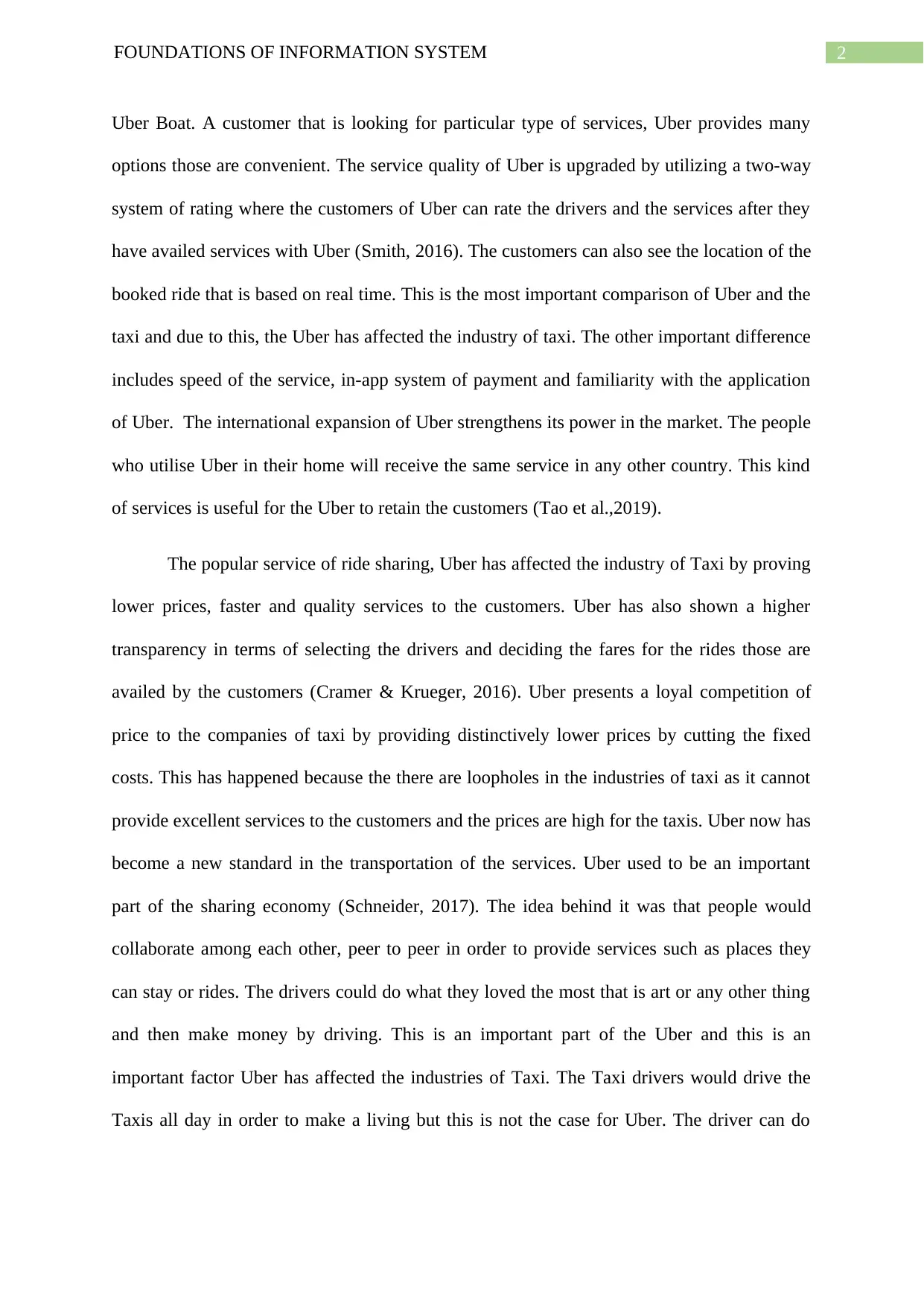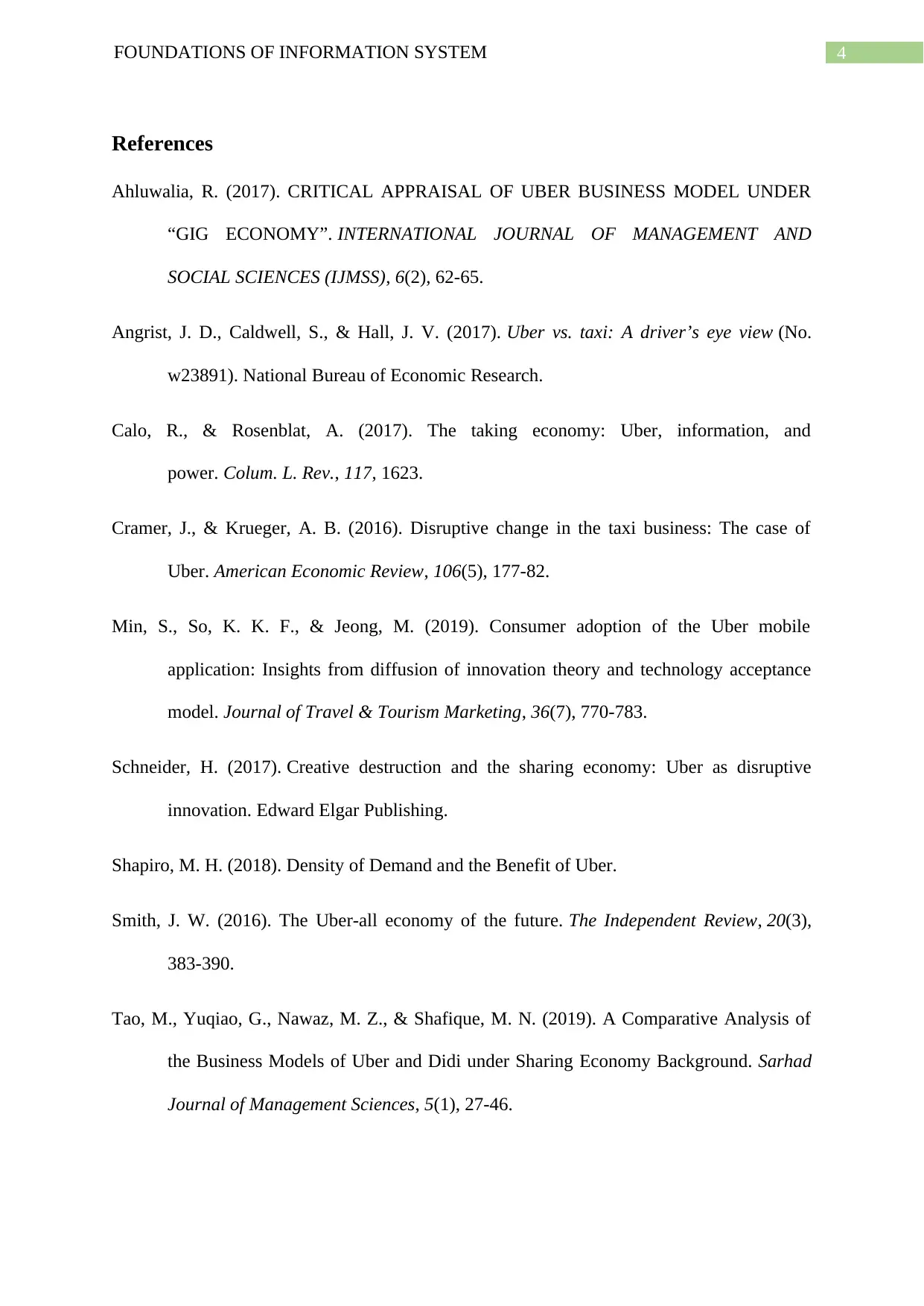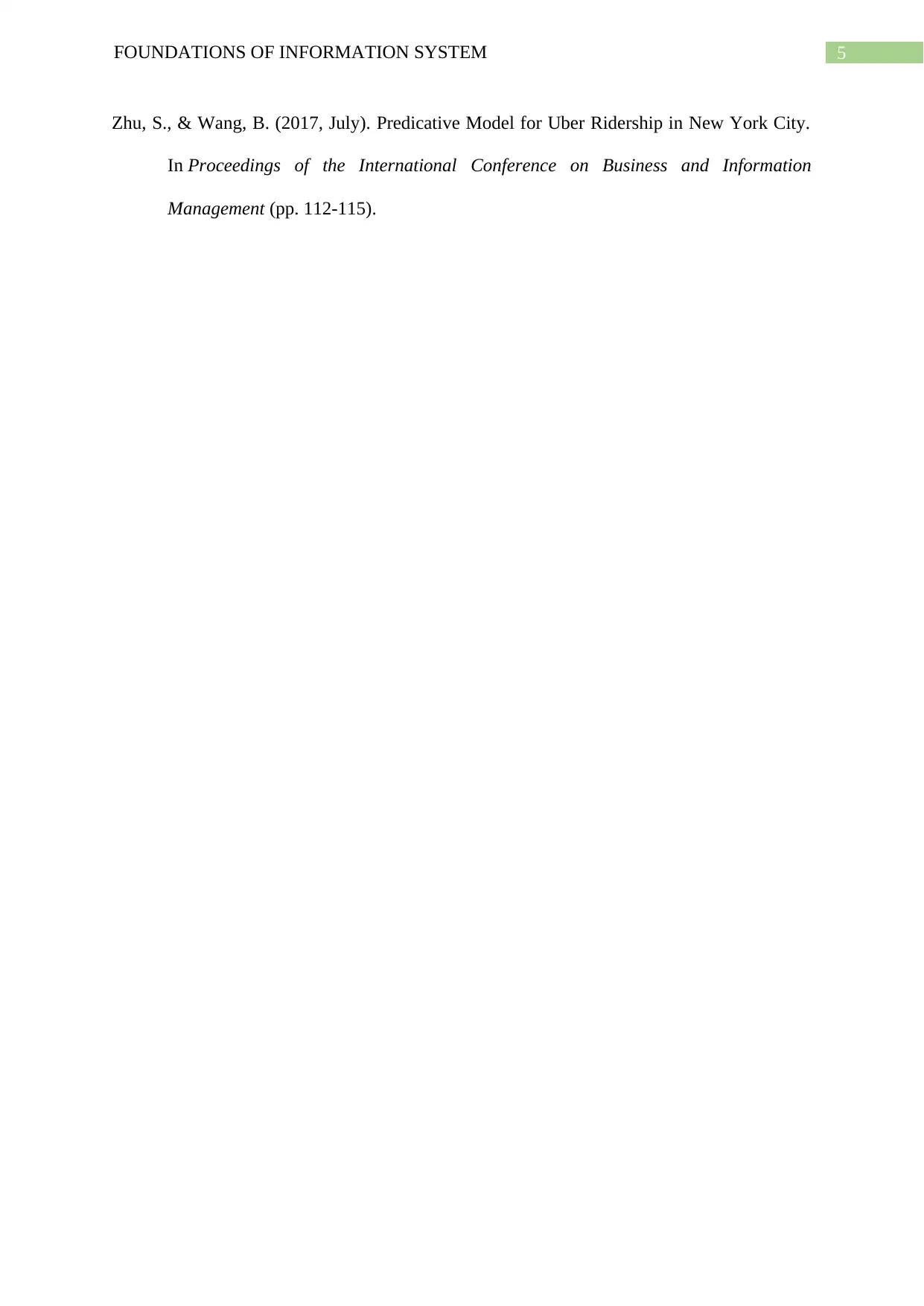Foundations of Information Systems: Uber's Business Model and Impact
VerifiedAdded on 2022/08/15
|6
|1503
|31
Report
AI Summary
This report provides an in-depth analysis of Uber's business model and its disruptive impact on the traditional taxi industry. It explores the information systems utilized by Uber, including management information systems and geographic information systems, and how these systems contribute to its operational efficiency and customer service. The report highlights key differences between Uber and traditional taxis, such as dynamic pricing, service variety, and the use of a two-way rating system. It also examines Uber's international expansion and its role in the sharing economy. The analysis includes a discussion of Uber's competitive advantages, the impact of its lower prices and enhanced services, and the challenges faced by the taxi industry. The report concludes by emphasizing Uber's position as a new standard in transportation services and its ability to provide better quality and faster service to its customers. The report references several academic sources to support its findings.

Running head: FOUNDATIONS OF INFORMATION SYSTEM
FOUNDATIONS OF INFORMATION SYSTEM
Name of the Student
Name of the University
Author Note
FOUNDATIONS OF INFORMATION SYSTEM
Name of the Student
Name of the University
Author Note
Paraphrase This Document
Need a fresh take? Get an instant paraphrase of this document with our AI Paraphraser

1FOUNDATIONS OF INFORMATION SYSTEM
Discussions
The Uber has become one of the most important parts in the life of people. The use of
Uber has increased in this decade as people have increased the use of Uber. This increase in
the use of Uber has highly affected the taxi industry and they are in the verge of a great loss.
The disruptive companies like the Uber, Ola and Lyft has affected the industry of taxi and the
business of taxi industry (Zhu & Wang, 2017). These companies have utilised various
information systems in order to create new models of business and increase their revenue by
providing excellent services to the customers and providing them services 24 hours and 7
days. The information system used by Uber includes a management information system and a
geographic information system (Min et al., 2019). The geographic information system will
help the Uber to find the location of the customers and the management information system
of Uber consist of hardware and software and it helps to improve the operations of Uber. This
information system with gather data from more than one online systems, examine the
information and provide reports to the company so that the organizations can make proper
decisions and handle the customers properly. The Uber business model is very strong and the
other companies are trying to replicate this business model in order to earn more revenues.
Uber has some important differences that set it apart from the companies of Taxi. The first
comparison is the dynamic system of pricing and it is powered by the algorithms of computer
that work with the data that is collected from the Uber app and there is a lack in the supply of
vehicles those are available during the hours of rush or during the rainy season (Ahluwalia,
2017). Based on the number of end user that open the Uber application, the algorithm of Uber
calculates a surge in the price that causes a lower demand and a higher supply. The taxis
usually provide one kind of vehicles, the colour of the vehicle is standard, and the model of
the car is standard. However, Uber has various forms of services and the cheapest and the
most used Uber service is UberX. Uber has various types of services like the Uber Eats and
Discussions
The Uber has become one of the most important parts in the life of people. The use of
Uber has increased in this decade as people have increased the use of Uber. This increase in
the use of Uber has highly affected the taxi industry and they are in the verge of a great loss.
The disruptive companies like the Uber, Ola and Lyft has affected the industry of taxi and the
business of taxi industry (Zhu & Wang, 2017). These companies have utilised various
information systems in order to create new models of business and increase their revenue by
providing excellent services to the customers and providing them services 24 hours and 7
days. The information system used by Uber includes a management information system and a
geographic information system (Min et al., 2019). The geographic information system will
help the Uber to find the location of the customers and the management information system
of Uber consist of hardware and software and it helps to improve the operations of Uber. This
information system with gather data from more than one online systems, examine the
information and provide reports to the company so that the organizations can make proper
decisions and handle the customers properly. The Uber business model is very strong and the
other companies are trying to replicate this business model in order to earn more revenues.
Uber has some important differences that set it apart from the companies of Taxi. The first
comparison is the dynamic system of pricing and it is powered by the algorithms of computer
that work with the data that is collected from the Uber app and there is a lack in the supply of
vehicles those are available during the hours of rush or during the rainy season (Ahluwalia,
2017). Based on the number of end user that open the Uber application, the algorithm of Uber
calculates a surge in the price that causes a lower demand and a higher supply. The taxis
usually provide one kind of vehicles, the colour of the vehicle is standard, and the model of
the car is standard. However, Uber has various forms of services and the cheapest and the
most used Uber service is UberX. Uber has various types of services like the Uber Eats and

2FOUNDATIONS OF INFORMATION SYSTEM
Uber Boat. A customer that is looking for particular type of services, Uber provides many
options those are convenient. The service quality of Uber is upgraded by utilizing a two-way
system of rating where the customers of Uber can rate the drivers and the services after they
have availed services with Uber (Smith, 2016). The customers can also see the location of the
booked ride that is based on real time. This is the most important comparison of Uber and the
taxi and due to this, the Uber has affected the industry of taxi. The other important difference
includes speed of the service, in-app system of payment and familiarity with the application
of Uber. The international expansion of Uber strengthens its power in the market. The people
who utilise Uber in their home will receive the same service in any other country. This kind
of services is useful for the Uber to retain the customers (Tao et al.,2019).
The popular service of ride sharing, Uber has affected the industry of Taxi by proving
lower prices, faster and quality services to the customers. Uber has also shown a higher
transparency in terms of selecting the drivers and deciding the fares for the rides those are
availed by the customers (Cramer & Krueger, 2016). Uber presents a loyal competition of
price to the companies of taxi by providing distinctively lower prices by cutting the fixed
costs. This has happened because the there are loopholes in the industries of taxi as it cannot
provide excellent services to the customers and the prices are high for the taxis. Uber now has
become a new standard in the transportation of the services. Uber used to be an important
part of the sharing economy (Schneider, 2017). The idea behind it was that people would
collaborate among each other, peer to peer in order to provide services such as places they
can stay or rides. The drivers could do what they loved the most that is art or any other thing
and then make money by driving. This is an important part of the Uber and this is an
important factor Uber has affected the industries of Taxi. The Taxi drivers would drive the
Taxis all day in order to make a living but this is not the case for Uber. The driver can do
Uber Boat. A customer that is looking for particular type of services, Uber provides many
options those are convenient. The service quality of Uber is upgraded by utilizing a two-way
system of rating where the customers of Uber can rate the drivers and the services after they
have availed services with Uber (Smith, 2016). The customers can also see the location of the
booked ride that is based on real time. This is the most important comparison of Uber and the
taxi and due to this, the Uber has affected the industry of taxi. The other important difference
includes speed of the service, in-app system of payment and familiarity with the application
of Uber. The international expansion of Uber strengthens its power in the market. The people
who utilise Uber in their home will receive the same service in any other country. This kind
of services is useful for the Uber to retain the customers (Tao et al.,2019).
The popular service of ride sharing, Uber has affected the industry of Taxi by proving
lower prices, faster and quality services to the customers. Uber has also shown a higher
transparency in terms of selecting the drivers and deciding the fares for the rides those are
availed by the customers (Cramer & Krueger, 2016). Uber presents a loyal competition of
price to the companies of taxi by providing distinctively lower prices by cutting the fixed
costs. This has happened because the there are loopholes in the industries of taxi as it cannot
provide excellent services to the customers and the prices are high for the taxis. Uber now has
become a new standard in the transportation of the services. Uber used to be an important
part of the sharing economy (Schneider, 2017). The idea behind it was that people would
collaborate among each other, peer to peer in order to provide services such as places they
can stay or rides. The drivers could do what they loved the most that is art or any other thing
and then make money by driving. This is an important part of the Uber and this is an
important factor Uber has affected the industries of Taxi. The Taxi drivers would drive the
Taxis all day in order to make a living but this is not the case for Uber. The driver can do
⊘ This is a preview!⊘
Do you want full access?
Subscribe today to unlock all pages.

Trusted by 1+ million students worldwide

3FOUNDATIONS OF INFORMATION SYSTEM
anything according to their wish and then drive Uber for a little money. This concept is
known as the shared economy (Calo & Rosenblat, 2017).
It is seen that Uber is a much better substitute for the taxis. Besides the prices those
are competitive, Uber provides very fast services by utilising the applications installed on
their smartphone, better service quality, likelihood of selecting the vehicles, drivers and many
more. The companies of taxi are under the control of central and local authorities and they
have less effect on the tariffs of the ride (Shapiro, 2018). Uber on the other hand has freedom
in selecting its policy of price. Most of the companies of taxi hold some sort of monopoly in
the places that the taxis operate. When they are seen together, all of the services of taxi in a
city have the same quality of the services. Uber generally provides vehicles those are of better
quality that attracts various customers and justifies a higher price than the taxis those are
regular and those are availed by the normal people. Not all the functionalities that the Uber
provides and the normal taxis do imply that the customers will select the Uber over the taxis.
A standard that is new in the speed and the quality of the services those are introduced by the
Uber in the market can be a positive incentive for the companies of Taxi (Angrist, Caldwell
& Hall, 2017). A dose that is healthy benefits the customers in the very long run.
anything according to their wish and then drive Uber for a little money. This concept is
known as the shared economy (Calo & Rosenblat, 2017).
It is seen that Uber is a much better substitute for the taxis. Besides the prices those
are competitive, Uber provides very fast services by utilising the applications installed on
their smartphone, better service quality, likelihood of selecting the vehicles, drivers and many
more. The companies of taxi are under the control of central and local authorities and they
have less effect on the tariffs of the ride (Shapiro, 2018). Uber on the other hand has freedom
in selecting its policy of price. Most of the companies of taxi hold some sort of monopoly in
the places that the taxis operate. When they are seen together, all of the services of taxi in a
city have the same quality of the services. Uber generally provides vehicles those are of better
quality that attracts various customers and justifies a higher price than the taxis those are
regular and those are availed by the normal people. Not all the functionalities that the Uber
provides and the normal taxis do imply that the customers will select the Uber over the taxis.
A standard that is new in the speed and the quality of the services those are introduced by the
Uber in the market can be a positive incentive for the companies of Taxi (Angrist, Caldwell
& Hall, 2017). A dose that is healthy benefits the customers in the very long run.
Paraphrase This Document
Need a fresh take? Get an instant paraphrase of this document with our AI Paraphraser

4FOUNDATIONS OF INFORMATION SYSTEM
References
Ahluwalia, R. (2017). CRITICAL APPRAISAL OF UBER BUSINESS MODEL UNDER
“GIG ECONOMY”. INTERNATIONAL JOURNAL OF MANAGEMENT AND
SOCIAL SCIENCES (IJMSS), 6(2), 62-65.
Angrist, J. D., Caldwell, S., & Hall, J. V. (2017). Uber vs. taxi: A driver’s eye view (No.
w23891). National Bureau of Economic Research.
Calo, R., & Rosenblat, A. (2017). The taking economy: Uber, information, and
power. Colum. L. Rev., 117, 1623.
Cramer, J., & Krueger, A. B. (2016). Disruptive change in the taxi business: The case of
Uber. American Economic Review, 106(5), 177-82.
Min, S., So, K. K. F., & Jeong, M. (2019). Consumer adoption of the Uber mobile
application: Insights from diffusion of innovation theory and technology acceptance
model. Journal of Travel & Tourism Marketing, 36(7), 770-783.
Schneider, H. (2017). Creative destruction and the sharing economy: Uber as disruptive
innovation. Edward Elgar Publishing.
Shapiro, M. H. (2018). Density of Demand and the Benefit of Uber.
Smith, J. W. (2016). The Uber-all economy of the future. The Independent Review, 20(3),
383-390.
Tao, M., Yuqiao, G., Nawaz, M. Z., & Shafique, M. N. (2019). A Comparative Analysis of
the Business Models of Uber and Didi under Sharing Economy Background. Sarhad
Journal of Management Sciences, 5(1), 27-46.
References
Ahluwalia, R. (2017). CRITICAL APPRAISAL OF UBER BUSINESS MODEL UNDER
“GIG ECONOMY”. INTERNATIONAL JOURNAL OF MANAGEMENT AND
SOCIAL SCIENCES (IJMSS), 6(2), 62-65.
Angrist, J. D., Caldwell, S., & Hall, J. V. (2017). Uber vs. taxi: A driver’s eye view (No.
w23891). National Bureau of Economic Research.
Calo, R., & Rosenblat, A. (2017). The taking economy: Uber, information, and
power. Colum. L. Rev., 117, 1623.
Cramer, J., & Krueger, A. B. (2016). Disruptive change in the taxi business: The case of
Uber. American Economic Review, 106(5), 177-82.
Min, S., So, K. K. F., & Jeong, M. (2019). Consumer adoption of the Uber mobile
application: Insights from diffusion of innovation theory and technology acceptance
model. Journal of Travel & Tourism Marketing, 36(7), 770-783.
Schneider, H. (2017). Creative destruction and the sharing economy: Uber as disruptive
innovation. Edward Elgar Publishing.
Shapiro, M. H. (2018). Density of Demand and the Benefit of Uber.
Smith, J. W. (2016). The Uber-all economy of the future. The Independent Review, 20(3),
383-390.
Tao, M., Yuqiao, G., Nawaz, M. Z., & Shafique, M. N. (2019). A Comparative Analysis of
the Business Models of Uber and Didi under Sharing Economy Background. Sarhad
Journal of Management Sciences, 5(1), 27-46.

5FOUNDATIONS OF INFORMATION SYSTEM
Zhu, S., & Wang, B. (2017, July). Predicative Model for Uber Ridership in New York City.
In Proceedings of the International Conference on Business and Information
Management (pp. 112-115).
Zhu, S., & Wang, B. (2017, July). Predicative Model for Uber Ridership in New York City.
In Proceedings of the International Conference on Business and Information
Management (pp. 112-115).
⊘ This is a preview!⊘
Do you want full access?
Subscribe today to unlock all pages.

Trusted by 1+ million students worldwide
1 out of 6
Related Documents
Your All-in-One AI-Powered Toolkit for Academic Success.
+13062052269
info@desklib.com
Available 24*7 on WhatsApp / Email
![[object Object]](/_next/static/media/star-bottom.7253800d.svg)
Unlock your academic potential
Copyright © 2020–2025 A2Z Services. All Rights Reserved. Developed and managed by ZUCOL.




